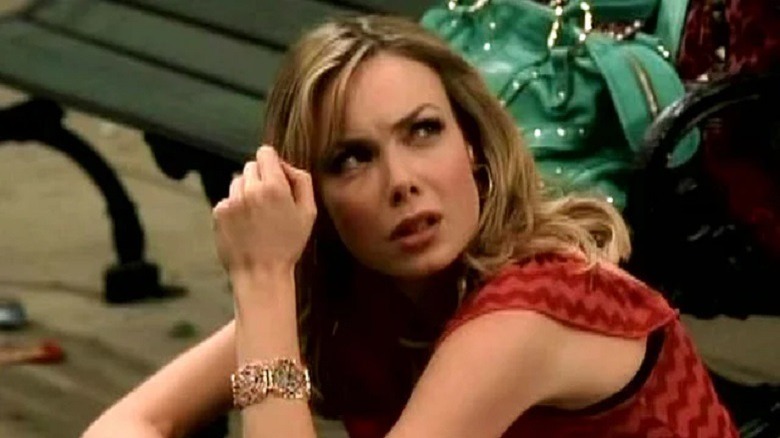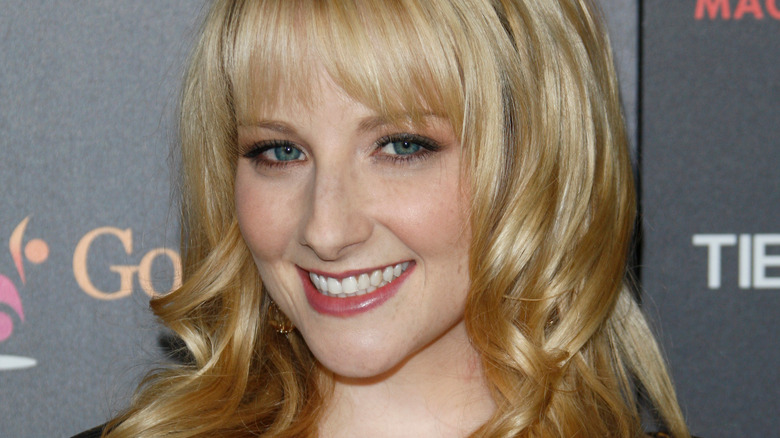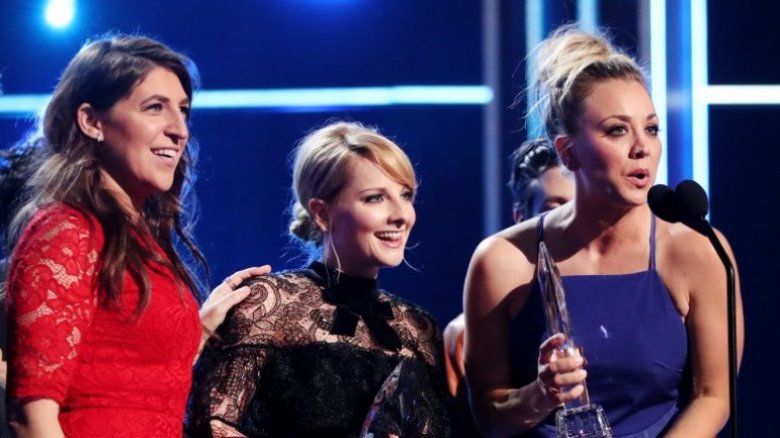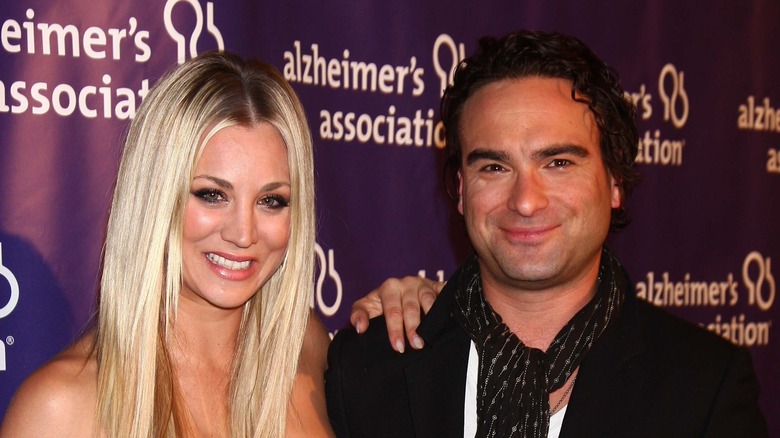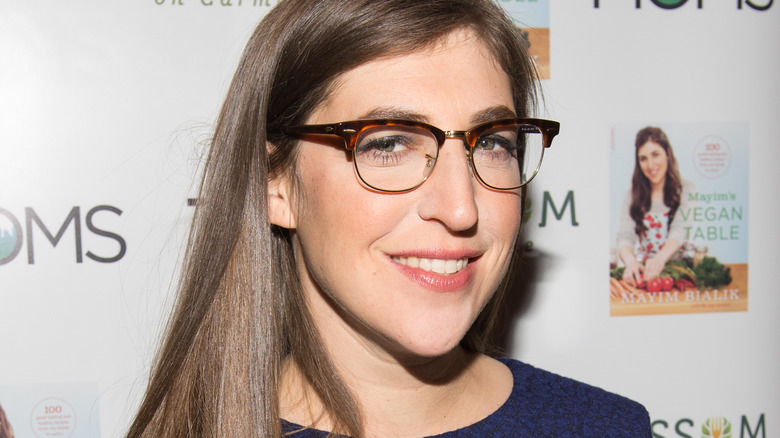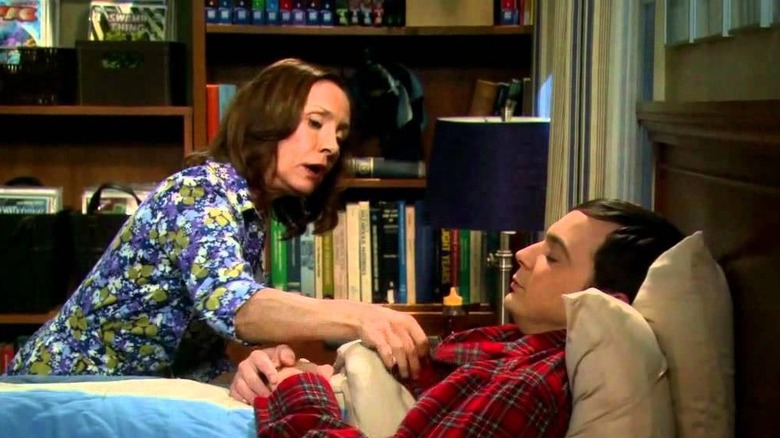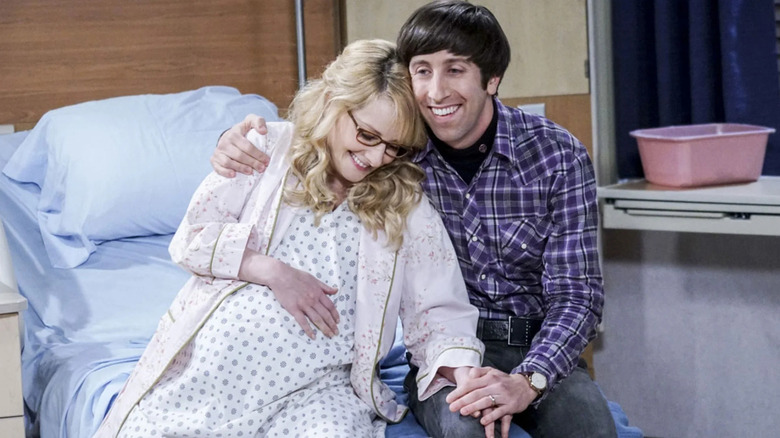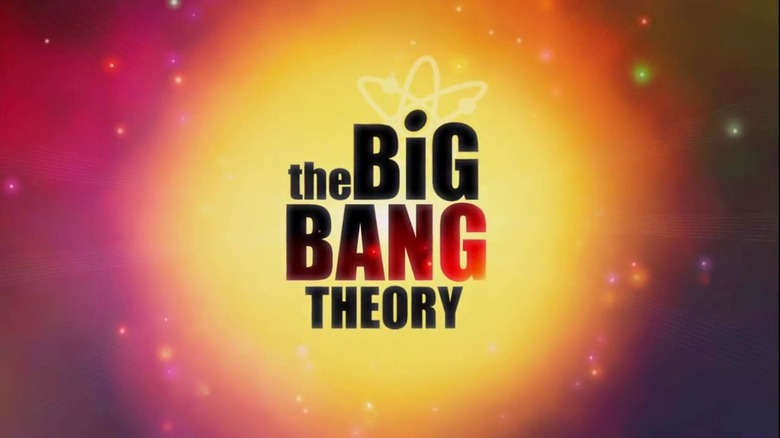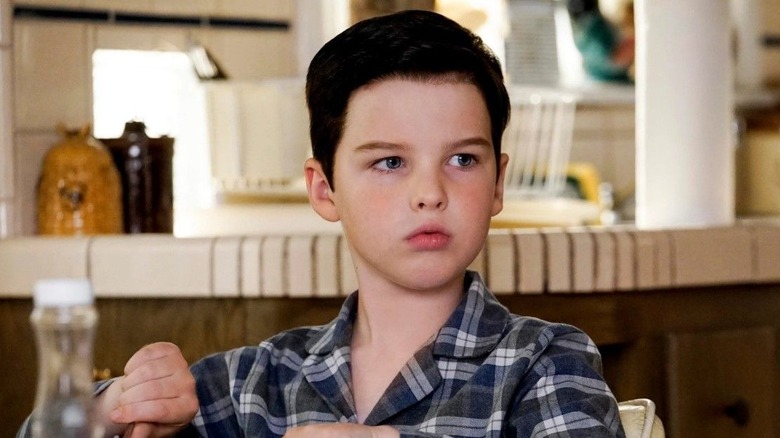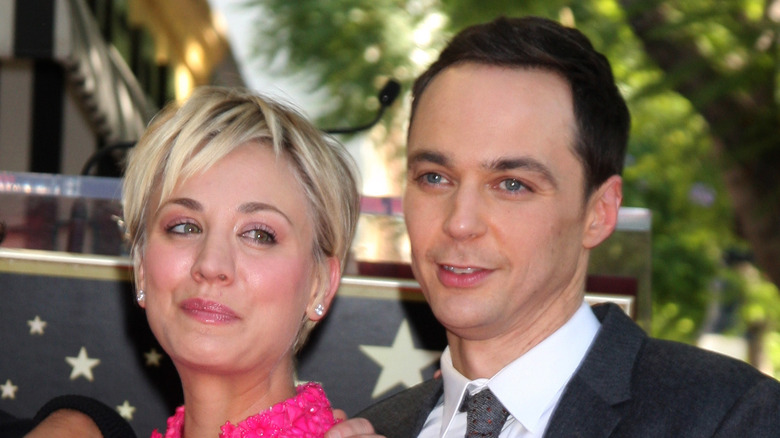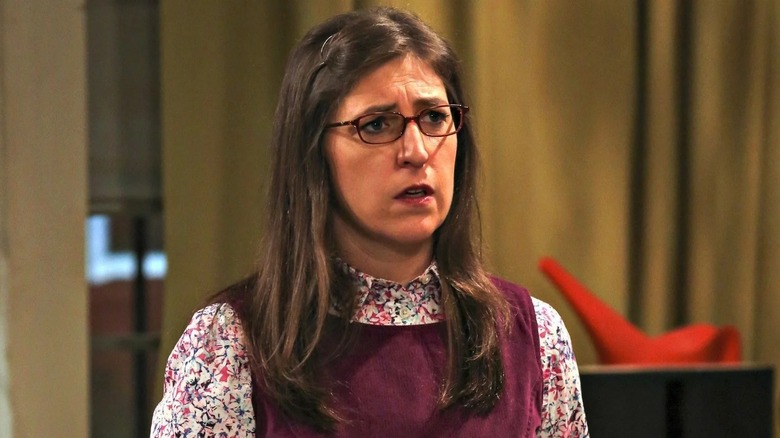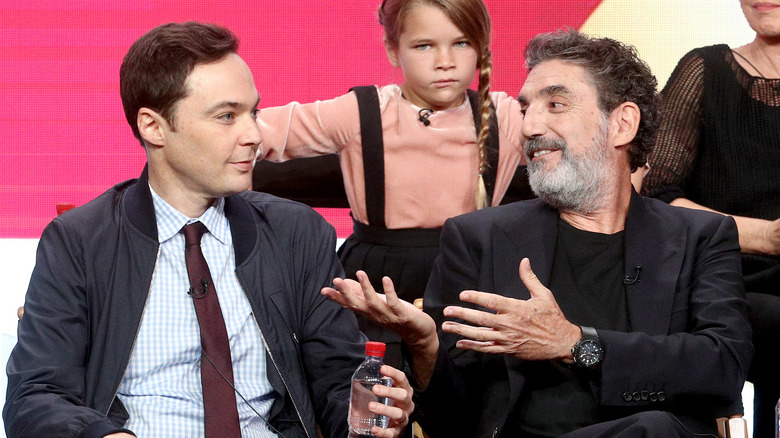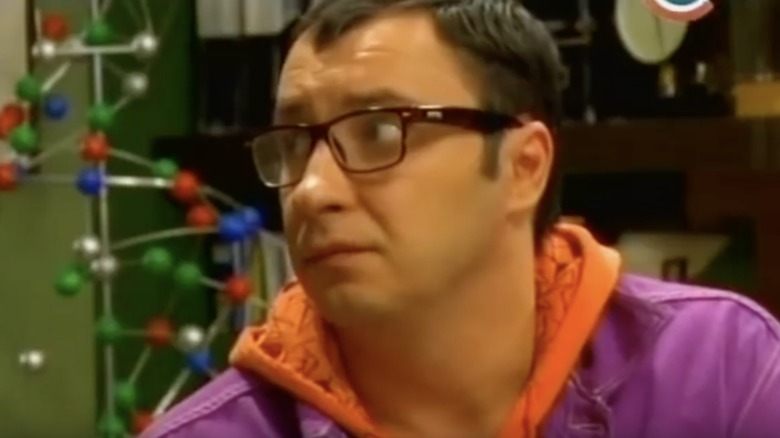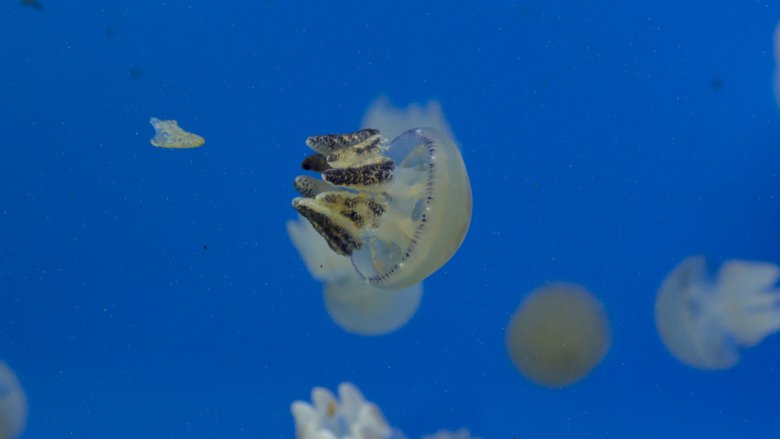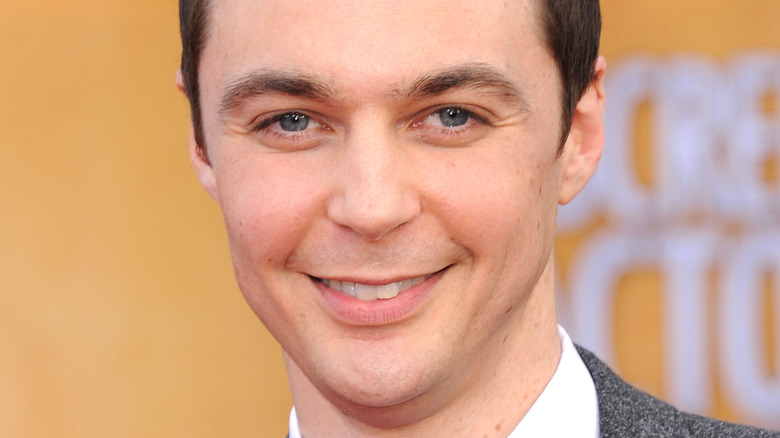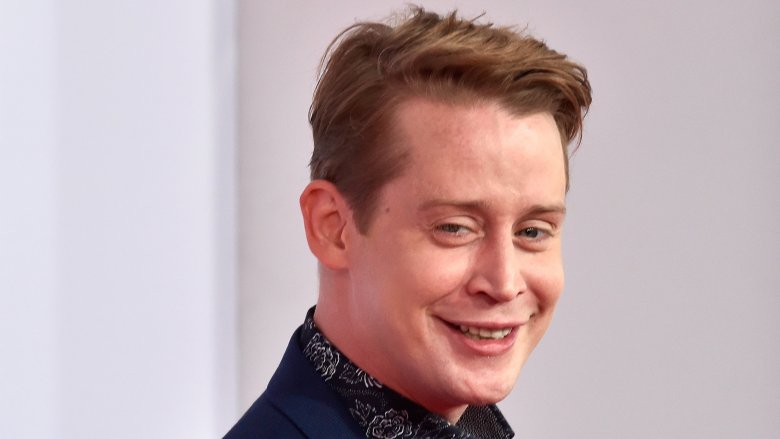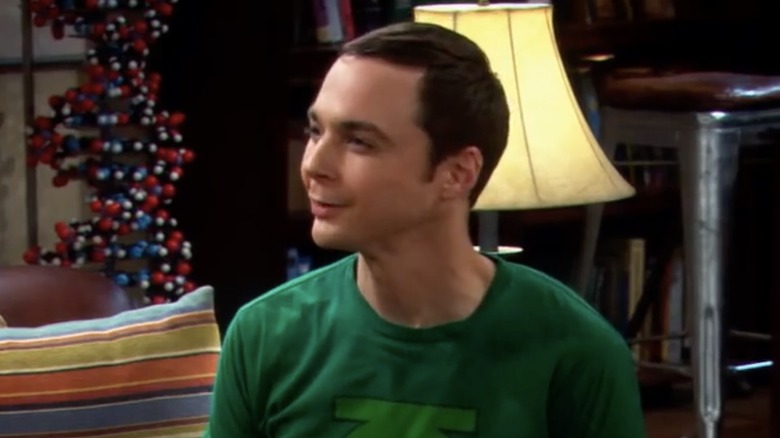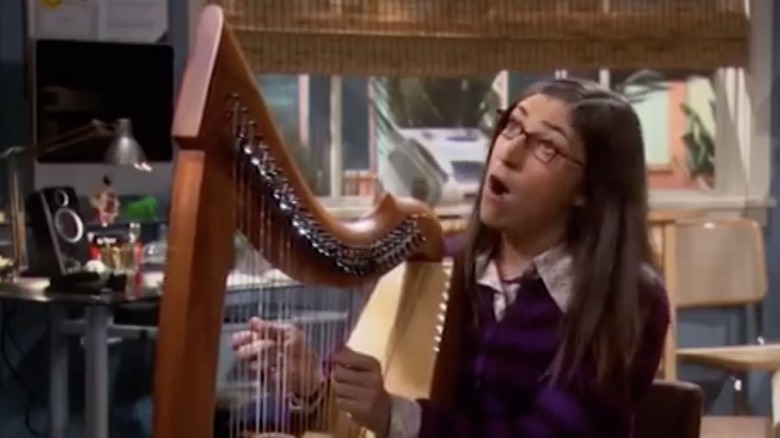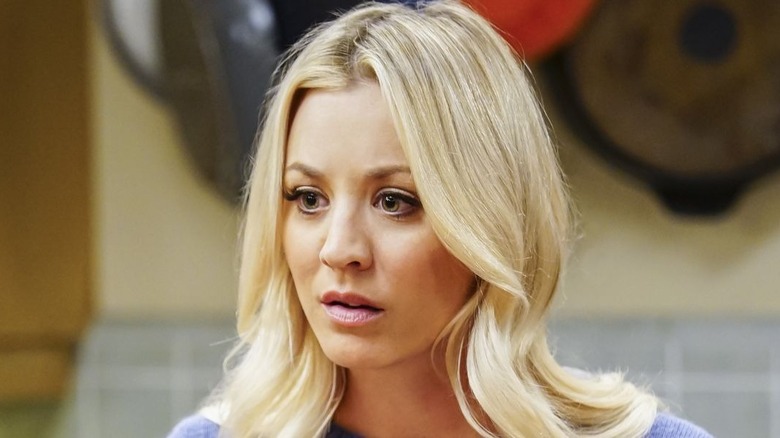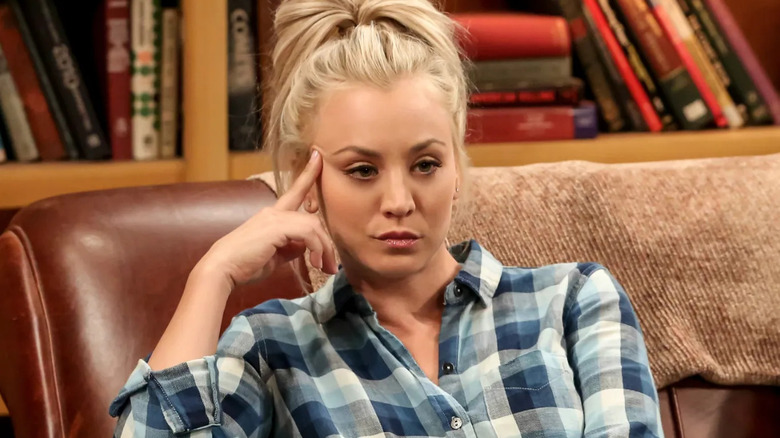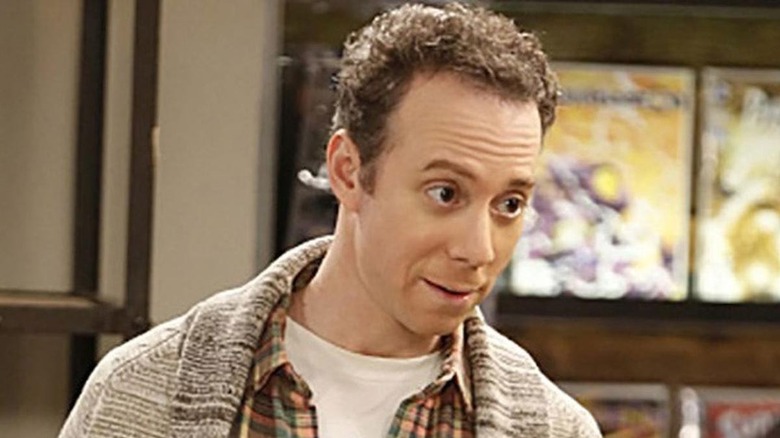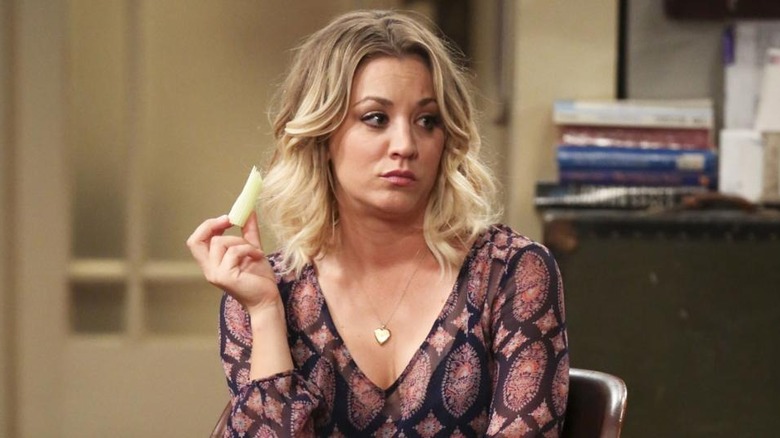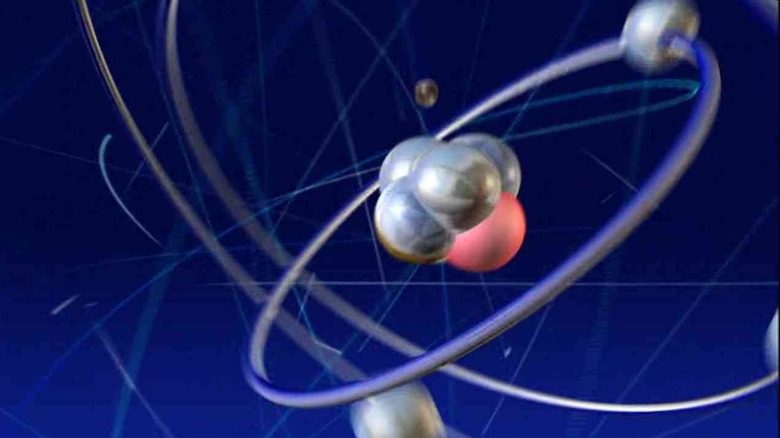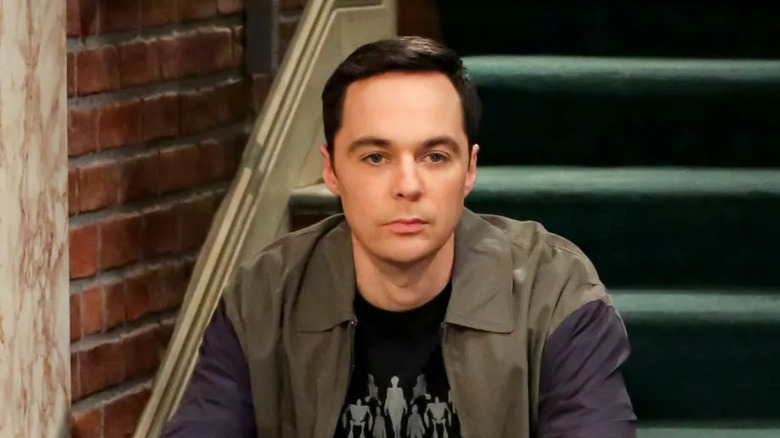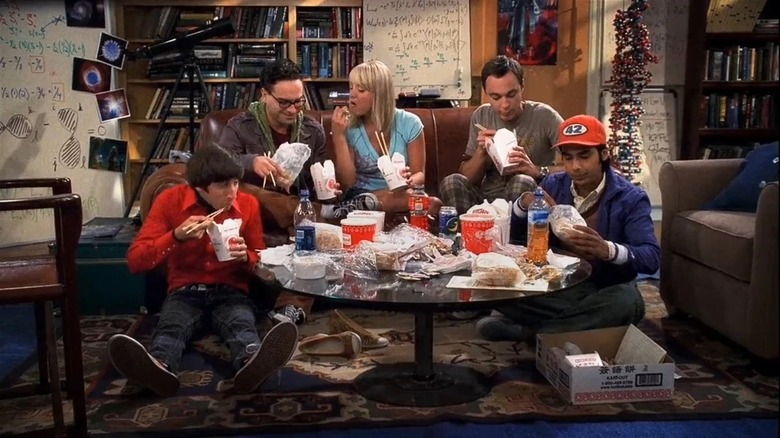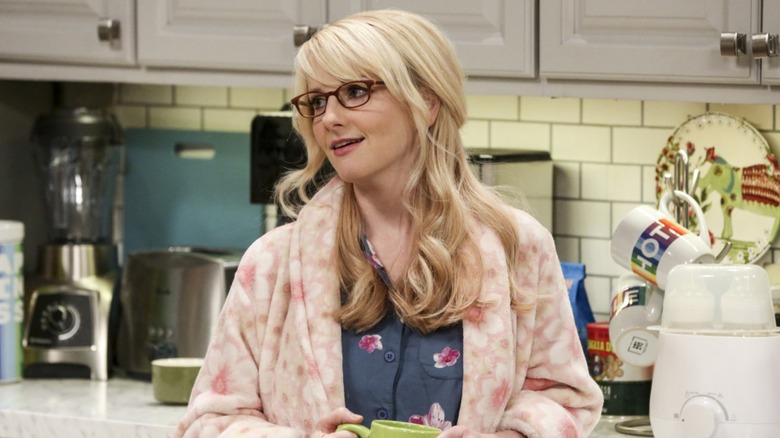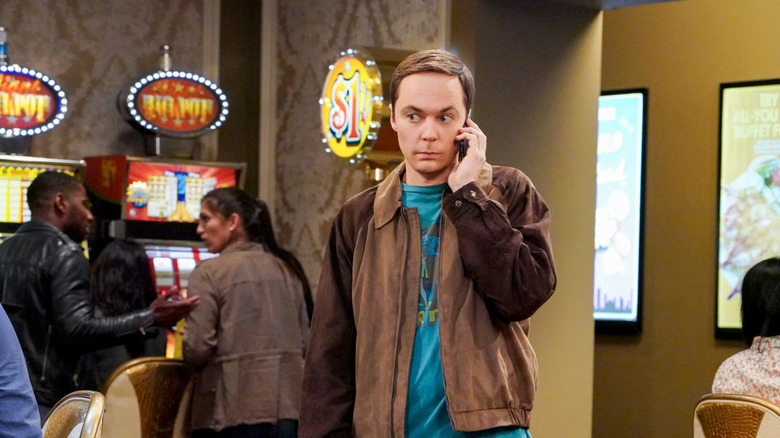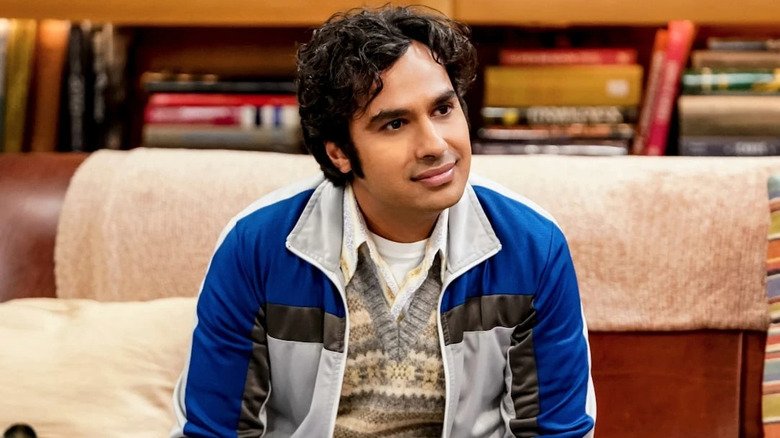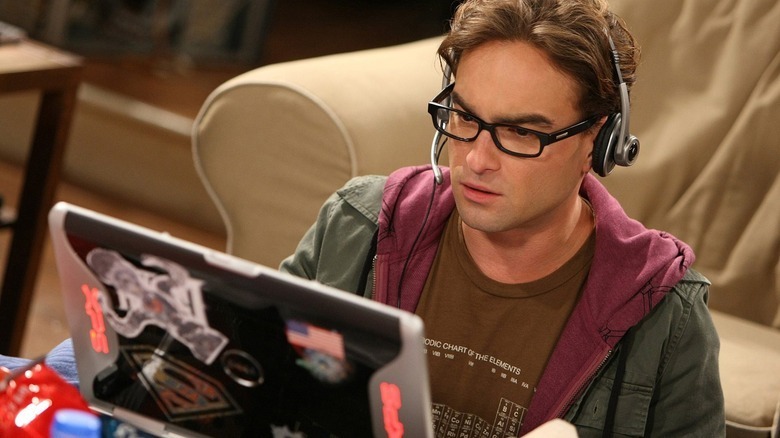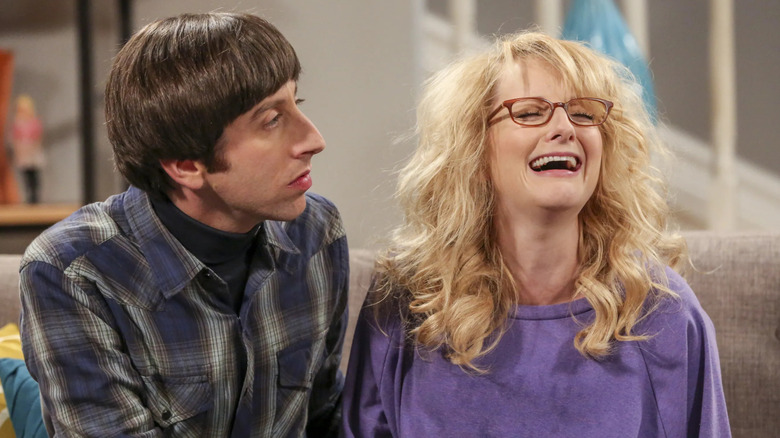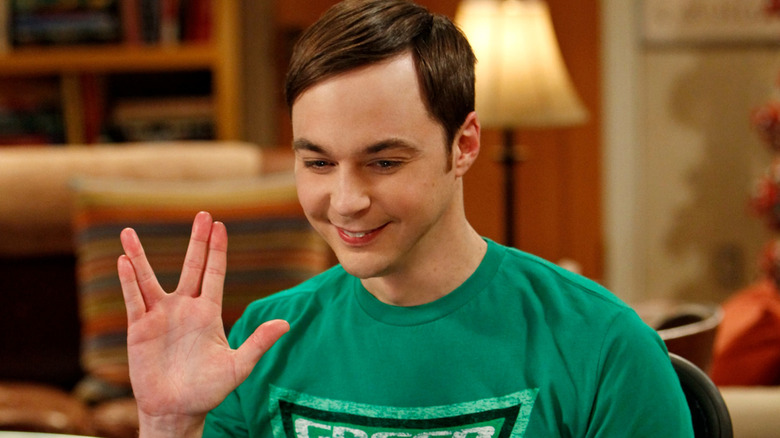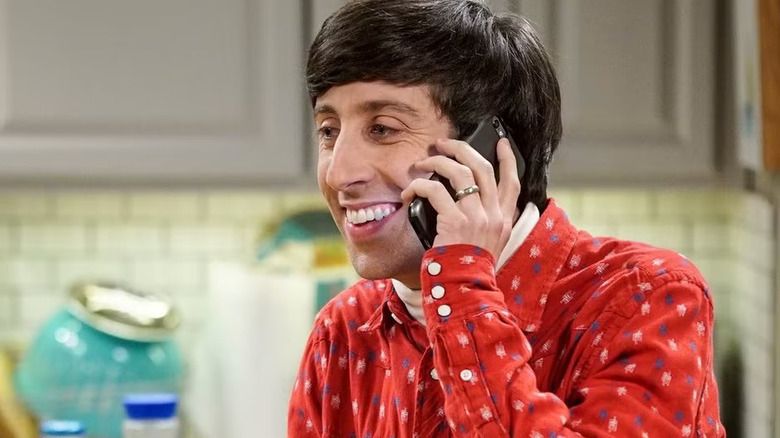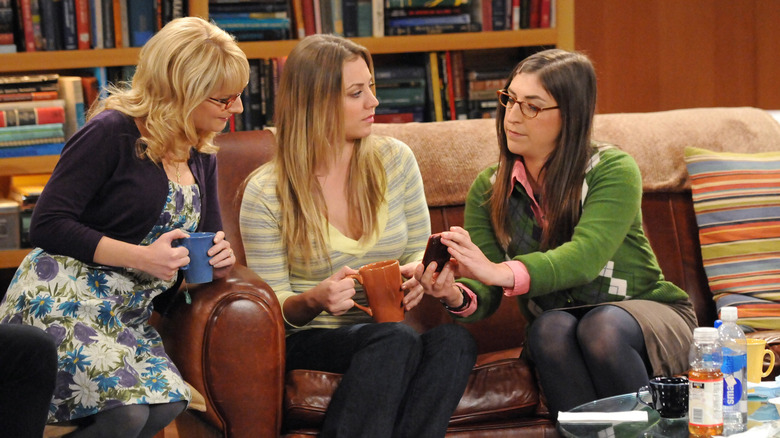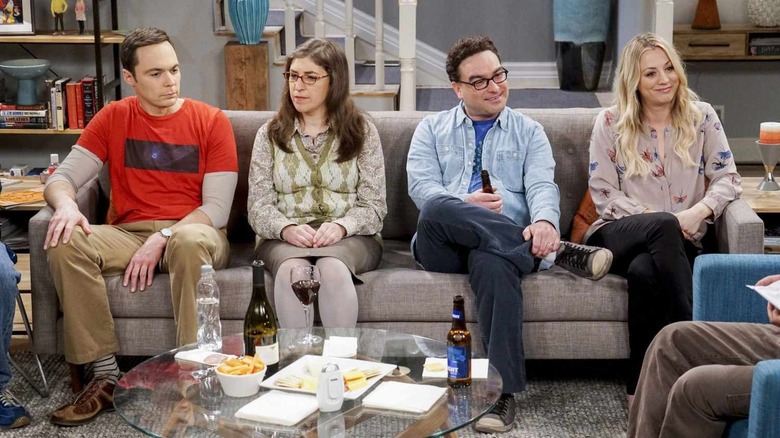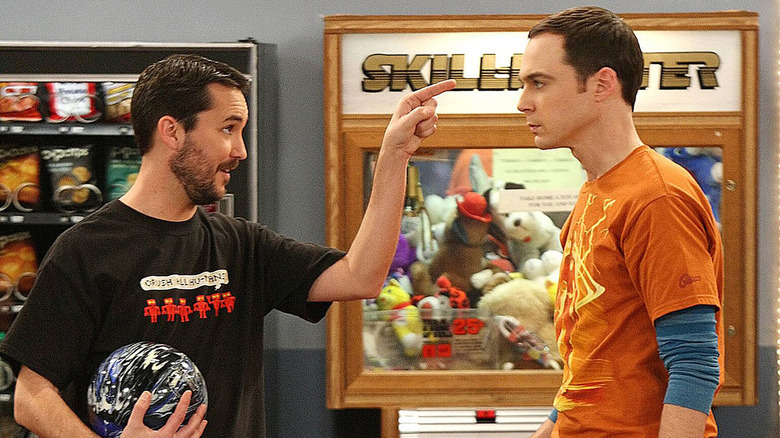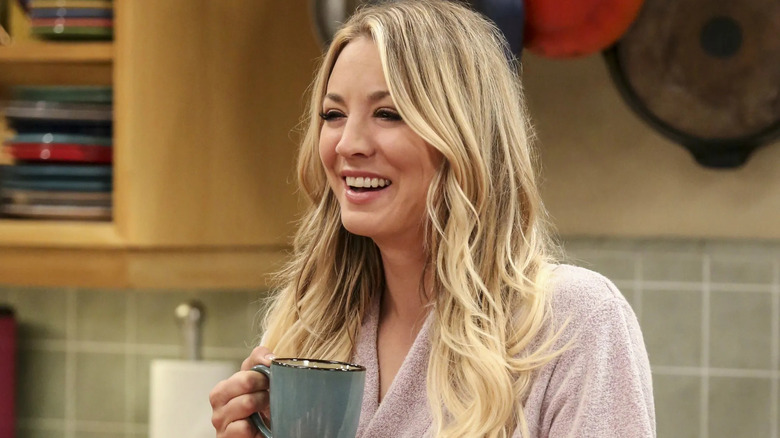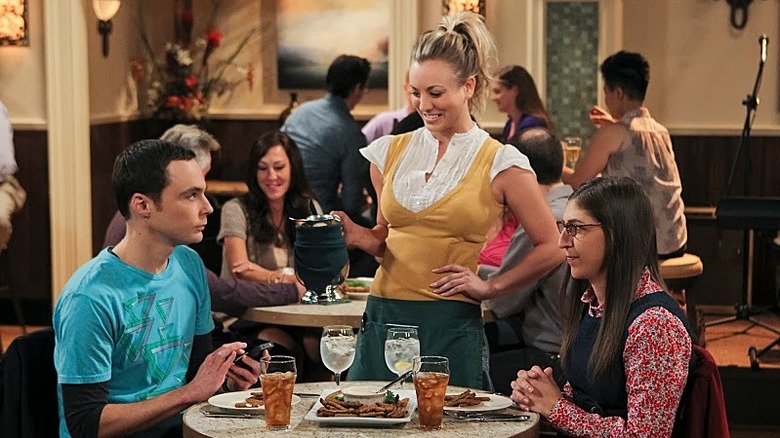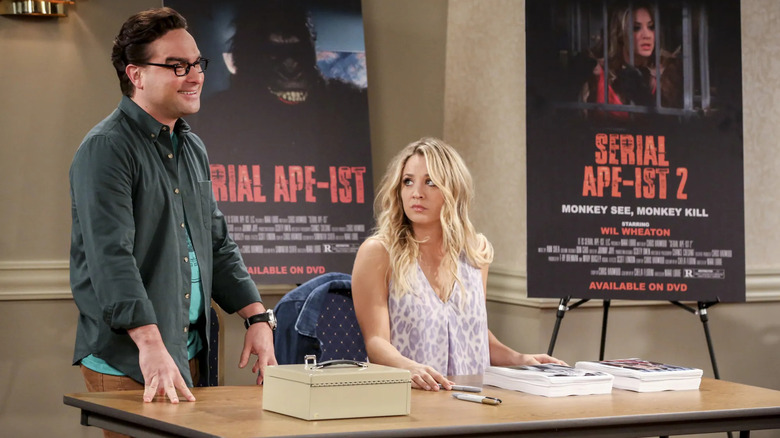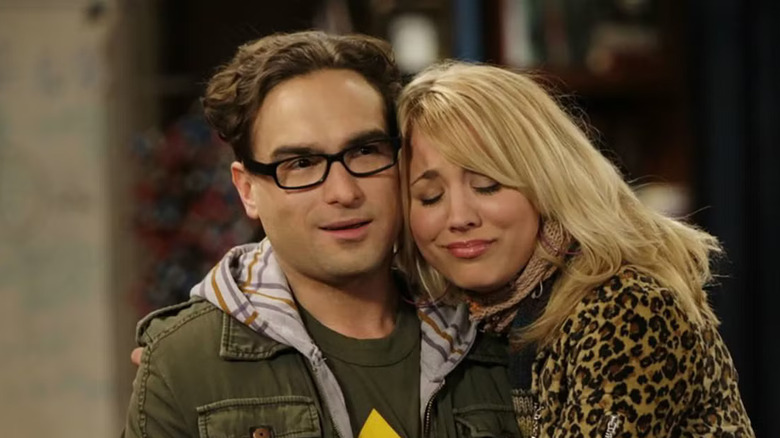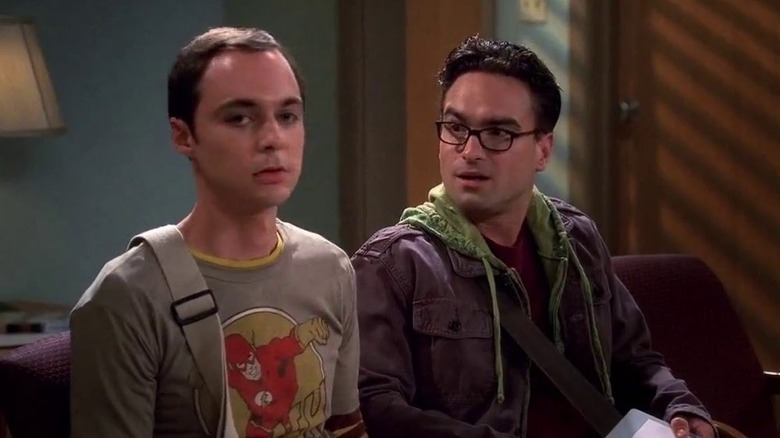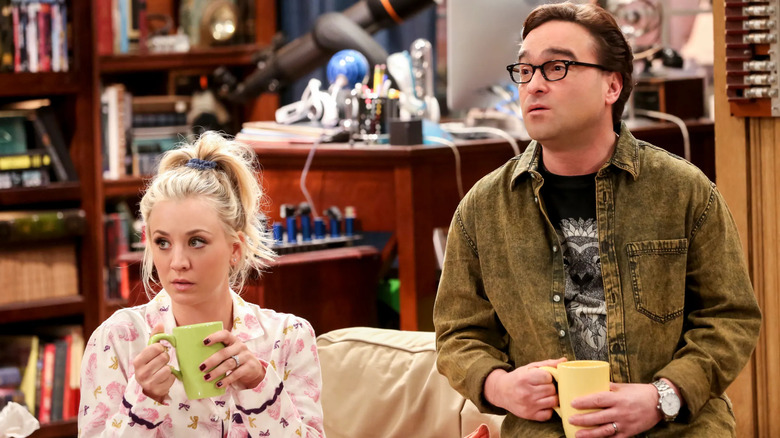The Big Bang Theory Details That Will Unlock Your Inner Nerd
"The Big Bang Theory" quietly debuted on CBS in 2007. Once reruns of the show started running around the clock on local stations and cable, the ensemble sitcom exploded in popularity. While those reruns dominate the list of most-watched cable shows, the original episodes routinely rank near the top of the weekly network TV ratings — it's been the most-watched sitcom on TV for years.
It's a low-key security blanket of a show for millions of Americans who enjoy the personal and professional adventures of the Caltech-based group of (mostly) super-genius scientists, including prickly and particular theoretical physicist Sheldon Cooper (Jim Parsons), friendly experimental physicist Leonard Hofstadter (Johnny Galecki), lovelorn and sensitive astrophysicist Raj (Kunal Nayyar), and socially awkward neurobiologist Amy Farrah Fowler (Mayim Bialik).
Here's a look at some stories and scandals behind the scenes of the America's favorite sitcom about science nerds and the people who love them.
The first pilot episode is unrecognizable
"The Big Bang Theory" that's aired for a decade-plus is very different from the pilot episode presented to CBS in 2006. While he's now depicted as largely asexual and mystified by romance (and other seemingly inefficient human pursuits), Sheldon (Jim Parsons) was outspokenly sexually active in the pilot. There was also no Penny (Kaley Cuoco); instead, the attractive neighbor role was filled by a tough, not-very-friendly woman named Katie (portrayed by Amanda Walsh). Even the optics were different — yet to discover his trademark hoodies, Leonard (Johnny Galecki) wore suits. There was one other noticeable difference: The theme song was Thomas Dolby's 1983 hit, "She Blinded Me With Science" (which is just a bit on the nose). CBS passed, but asked creators Chuck Lorre and Bill Prady to rework the show and submit another pilot. They did, extensively — and added in a new theme song from Barenaked Ladies — which made it to the network's fall schedule in 2007.
Melissa Rauch doesn't sound like that in real life
Over the years, the show has mined a lot of comedy from Bernadette's voice. When she's just talking to Howard or her friends, she speaks in a quiet, mousy, high-pitched way. But when she gets angry, she switches to loud (yet still high-pitched) moments of screaming rage. Neither of those voices come naturally to the actress behind Bernadette, Melissa Rauch, who sounds nothing like Bernadette in real life. In fact, her regular, off-screen speaking voice is quite normal — it's reminiscent of co-star Kaley Cuoco's, just a bit lower.
Rauch took her inspiration for Bernadette from a source close to home: her own mother. Although the two women share vocal DNA, they have one major difference — Bernadette lacks Rauch's mother's New Jersey accent. "Tonally, it's very similar," Rauch explained at a PaleyFest event. This means that when Bernadette would imitate Howard's late mother, who spoke with a Jersey accent, she was likely doing a fully accurate impression of her mom.
Big Bang Bucks
In 2014, contract re-negotiations between the cast and production company Warner Bros. TV delayed production on the show. Ultimately, CBS renewed the sitcom for three additional seasons, and the show's three leads — Jim Parsons, Johnny Galecki, and Kaley Cuoco — secured a salary of $1 million... per episode... each. Meanwhile, the show's male supporting actors (who'd been with the show since day one) also had to renegotiate their contracts. Simon Helberg (Howard) and Kunal Nayyar (Raj) bargained collectively, and both wound up with salaries of around $750,000 per episode. Thankfully for all parties involved, that settlement was reached the day before their old contracts ran out. Had Helberg and Nayyar not accepted the deal, "The Big Bang Theory" writers would have been ordered to write their characters off the show.
That leaves the other two major, long-term "The Big Bang Theory" cast members, Melissa Rauch and Mayim Bialik. They both joined the show later on in its run, and up until the 2016-17 season, both raked in a (relatively) meager $200,000 per episode. Then they got a major pay raise, thanks to their very generous co-stars. For the show's 11th and 12th seasons, the highest-paid cast members agreed to a pay cut down to $900,000 an episode each, with the expressed intent that the extra money went to giving Rauch and Bialik a raise, who would then earn about $450,000 an episode. (Best. Coworkers. Ever.)
Johnny Galecki and Kaley Cuoco secretly dated for years
In the early years of "The Big Bang Theory," Johnny Galecki dated one of the loveliest actresses in all of television, while Cuoco dated a handsome TV star herself. And both managed to keep their relationship secret. Surprise: Galecki and Cuoco dated each other, concurrent with their characters' budding romantic interest in one another... and almost nobody knew about it.
It wasn't until 2010, well after the couple amicably split, that either said anything publicly about their time together. Cuoco told company magazine CBS Watch! that she had dated Galecki "for almost two years. It was such a huge part of my life and nobody knew about it." That included never going "anywhere together." Three years later, Galecki gave his side of the story to CBS Watch! "We're dear friends, still," he said. "Kaley's not just an ex, she's a part of my life." So why were they so private about things? "I just don't like to speak about it," Galecki said. "And not because I'm trying to be enigmatic; I just worry that it will conflict with people's acceptance of Leonard and Penny."
The show starring Blossom is obsessed with Blossom
In the first season episode "The Bat Jar Conjecture," Sheldon quits the "Big Bang" boys' physics bowl team. The guys need a replacement, and fast, and Raj aims high in his suggestion for a replacement, naming "the girl who played TV's Blossom," because she'd gone on to earn a Ph.D in neuroscience in real life. "TV's Blossom" is actress Mayim Bialik, of course... who, a couple years after that episode aired, joined the cast of "The Big Bang Theory" as Amy Farrah Fowler (who also happens to be a neuroscientist).
Oddly, that's not the only time "The Big Bang Theory" has suggested that the television series "Blossom" — as well as a character on the show who looks exactly like the star of that show — exists in the show's universe. On a sixth season episode — long after Bialik joined the cast — Sheldon and Amy make a Venn diagram to determine a mutually agreeable Halloween "couples costume." Appearing in the list of pop culture couples Amy likes: "Blossom and Joey." (Amy certainly wouldn't have to do much to nail that look.)
Is Soft Kitty a copyright infringing kitty?
Co-creator Bill Prady says he heard Sheldon's special calm-down song being sung at his daughter's preschool. Assuming it was in the public domain, he added it to the show, where it's been used multiple times and on scores of "The Big Bang Theory" merchandise. In December 2015, however, the family of a New Hampshire preschool teacher named Edith Newlin sued CBS and Bill Prady Productions for copyright infringement, alleging they lifted lyrics without permission from a song Newlin wrote in the 1930s called "Warm Kitty." The main difference: The Newlin piece begins, "Warm kitty, soft kitty, little ball of fur." The Big Bang version starts out, "Soft kitty, warm kitty, little ball of fur." It appeared as such in a 1937 book called "Songs for the Nursery School."
In March 2017, U.S. District Judge Naomi Reice Buchwald dismissed the suit, ruling that Prady hadn't violated any copyright laws because Newlin's descendants couldn't actually prove that they had a copyright on "Warm Kitty."
You're never going to see those babies again
In the middle of the tenth season in 2016-17, a new character joined "The Big Bang Theory:" Halley, the newborn baby daughter of Howard and Bernadette. And while Howard and Bernadette's lives have been radically altered by starting a family, the baby itself doesn't show up on screen too much... like, ever. Showrunner Steve Molaro says that, apart from the Very Special Episode featuring Halley's birth, that baby will only ever be heard, and not seen, screaming and crying offscreen. It's a tribute to Carol Ann Susi, the unseen actress who played Howard's similarly always-screaming mother. Susi died in 2014, and her character subsequently did, too. Molaro added that "it also means we don't have to have a baby on set, so it solved lots of problems."
In 2018, Bernadette gave birth to baby number two, a boy named Neil (as in Armstrong, Gaiman, and Diamond). Executive producer Steve Holland told Entertainment Tonight that he'll probably honor Molaro's "no babies allowed" policy. "I'm not super excited to have someone haul their newborn twins and shove them in front of a camera," Holland said.
There's been a lawsuit over the theme song
Canadian pop-rock band Barenaked Ladies is responsible for "The Big Bang Theory Theme," which generates revenue for the band every time it's played on an episode of "The Big Bang Theory," which is quite often. The band has even recorded an extended version of it and included it on the band's greatest hits album. The catchy number has since made its way into the band's set list when they play live. But it's all not without controversy. Although longtime Barenaked Ladies member Steven Page left the band in 2009, he says he was promised a 20 percent cut of any profits the song generated. According to Page, he hasn't seen a dime of "The Big Bang Theory" theme song money. He filed suit, alleging that front man Ed Robertson has kept all the money for himself. According to legal documents, Page believes he's owed somewhere in the neighborhood of $1 million by the rest of the group, with whom he once, ironically, recorded the song "If I Had a Million Dollars."
It generated a spinoff
Almost every successful sitcom has launched a spinoff or two. "Cheers" led to "Frasier," "Happy Days" spawned "Laverne & Shirley," and "The Big Bang Theory" led to "Young Sheldon," a comedy that focuses on prickly genius Sheldon Cooper, back when he was a prickly child genius living in Texas. Iain Armitage stars as young Sheldon, while adult Sheldon's portrayer, Jim Parsons, narrates episodes. Unlike "The Big Bang Theory" with its multi-camera, laugh track-laden setup, "Young Sheldon" is a single-camera, laugh track-free show, akin to "Modern Family" or "Scrubs."
When Cuoco Met Parsons
Most of the cast of "The Big Bang Theory" are seasoned television veterans. Some, such as Mayim Bialik, Johnny Galecki, and Kaley Cuoco, all started acting when they were children. They've all been knocking around Hollywood for a while, and some had pre-existing relationships before "Big Bang." (Bialik, then of "Blossom," invited Galecki, then of "Roseanne," to her sixteenth birthday, but he missed it because he got in a motorcycle accident on the way. And Galecki and recurring guest star Sara Gilbert played a couple on "Roseanne" for years.)
Jim Parsons and Kaley Cuoco didn't know each other at all before "The Big Bang Theory," and they actually met for the first time while auditioning for the show on the same day. Cuoco introduced herself, but Parsons was busy, trying to figure out how to work his new Blackberry device. Cuoco said she remembered thinking Parsons would make a "hilarious Sheldon," although it's amusingly ironic that the man who would soon play a brilliant scientist couldn't get a simple consumer gadget to function properly.
The Big Bang Theory actor who doesn't care for The Big Bang Theory
Mayim Bialik joined the series as neuroscientist Amy Farrah Fowler in season 3 and very slowly became a love interest, then girlfriend, and then, improbably, a spouse for Sheldon, as well as a hopelessly devoted BFF to Penny. "The Big Bang Theory" had been on TV for a while by then, but Bialik hadn't quite managed to catch an episode. Bialik went in to the show cold — totally cold. "I had never seen 'The Big Bang Theory.' I knew it was a big deal because my manager told me, like, 'Try and get this part,'" Bialik said. As of 2016, she claims to have still not seen any "The Big Bang Theory" episodes produced before she joined, not to mention most of the ones that she actually appears in. "I don't have TV, so I don't really watch," Bialik said. (Sure, but she probably knows where to score some tapes.)
Wrong Chuck, Jim
For all of Chuck Lorre's success as a TV creator and producer, Jim Parsons had never heard of him when he was about to audition for "The Big Bang Theory." Well, actually, he thought the show was created by a different, similarly-named successful show business type. Parsons said on "The Late Show with David Letterman" that when his agent called him to say he'd landed an audition for the new "Chuck Lorre show," Parsons got confused and thought the agent meant Chuck Woolery, the host of game shows like "Scrabble" and "Love Connection." That made Parsons less than enthusiastic about the audition — after all, he figured it was a sitcom written by a game show host who hadn't worked prominently in TV since the 1980s. "I thought, why are they so excited about it?" Parsons admitted. "We should see what the man has to offer before we're like, 'It's a new Chuck Woolery pilot!'"
The Belarus Bang Theory
Every episode of "The Big Bang Theory" ends with a "title card" from Chuck Lorre. He writes a new one each time, and while it only appears on screen for a second or two, he uses it as a sounding board. In 2010, one such card reported on Lorre's discovery of a TV show from the Eastern European nation of Belarus called "The Theorists." The premise, according to Lorre's title card: "a sitcom about four nerdy scientists who live next door to a beautiful blonde waitress. The characters are named Sheldon, Leo, Hovard, Raj, and Natasha." The opening sequence for the show: "a rapid-fire montage of images which takes us from the dawn of time to the present moment." Lorre was convinced that "The Theorists" was majorly cribbing from "The Big Bang Theory," including the fact that "each episode appears to be a Russian translation of a 'Big Bang Theory' episode." Lawyers at Warner Bros. Television told Lorre there was little that could be done because the production company responsible for "The Theorists" was owned by the Belarusian government. (The show was canceled before long anyway.)
There's a species of jellyfish named after the show
In 2011, a photographer named Denis Riek spotted a tiny organism in the Brunswick River in the Australian state of New South Wales. Riek knew it was a jellyfish but couldn't readily identify it, so he sent his photos to jellyfish expert Dr. Lisa-ann Gershwin. After two years of research, Gershwin and her colleague, taxonomist Peter Davie, confirmed that the 15-millimeter creature was a previously undiscovered jellyfish. As one of the discoverers, Gershwin got to help name the species, and she went with Bazinga rieki. The first part of the name refers to Sheldon Cooper's catchphrase cry of triumph, "Bazinga!" — not unlike that of a scientist shouting "Eureka!" at a moment of great discovery. But Dr. Gershwin says it also refers to a musical instrument. "The name bazinga also refers to a seven-string harp, and the straight radial canals of this new species are reminiscent of such strings." (Bazinga!)
Buzzinga!
Biologists from the Universidade Federal de Uberlandia in Brazil announced the discovery of a new bee in 2013: the orchid bee. It so closely resembles another species of bee, the Euglossa ignita, that the researchers decided to go ahead and give the orchid bee its own official scientific name of Euglossa bazinga. Sheldon most often uses "Bazinga!" as a kind of "gotcha!" when he tricks someone or plays a prank on them. The biologists thought the word was a perfect way to describe such a tricky bee. That makes it one of few insects on Earth to ever be named after a sitcom catchphrase.
"The Big Bang Theory" showrunner Steven Molaro released a statement in response, on behalf of the fictional honoree. "Sheldon would be honored to know that Euglossa bazinga was inspired by him," Molaro said. "In fact, after Mothra and griffins, bees are his third-favorite flying creatures." (Bazinga!)
It's ending because of Jim Parsons
Just before CBS started airing the 12th season of "The Big Bang Theory." the show's powers that be announced that the upcoming batch of episodes would be its last. Co-creator and executive producer Chuck Lorre had gathered the cast in his office on the set on August 22, 2018, where star Jim Parsons, through tears, announced that he was leaving the show at season's end. Immediately after, Lorre told the cast that everyone would be leaving at season's end, because he'd opted to end the series rather than do it without Parsons (or Sheldon). According to Deadline, Parsons told Lorre of his decision a few days before that meeting, and plenty of executives secretly (although unsuccessfully) tried to get Parsons to change his mind. The four-time Emmy winner may have even turned down as much as $50 million to stay with "The Big Bang Theory" for two more seasons.
Mac attack? Denied!
When "The Big Bang Theory" was getting off the ground in the mid-2000s, former child superstar Macaulay Culkin was in the midst of a comeback. He'd ended a long hiatus with appearances in two indie films, the religious satire Saved and the club kid murder mystery "Party Monster." "The Big Bang Theory" producers wanted very much to be in business with the former Richie Rich and Kevin McAllister. Culkin guested on "The Joe Rogan Experience" podcast in 2018, and confessed that "they pursued me for 'The Big Bang Theory.' And I said no." The reason: He thought the show sounded terrible. "It was kind of like, the way the pitch was, 'All right, these two astrophysicist nerds and a pretty girl lives with them. Yoinks!' That was the pitch." Culkin didn't reveal which character he would've played, but he did add that he had to reject producers' overtures two more times. "Even my manager was like twisting my arm," Culkin added.
At last, the origins of Bazinga! revealed
Jim Parsons' occasionally sputtered utterance of "Bazinga!" is a classic TV catchphrase that ranks with the all-time great T-shirt-worthy TV expressions, such as "Cowabunga!" or "No soup for you!" It's Sheldon's preferred term of triumph for a well-executed prank on his scientist friends, such as jumping out of a ball pit, or emerging from the cushions of a couch. (Plus, it's fun to say "Bazinga!" Give it a try.)
The phrase — and the proper time to say it — is a direct carryover from the "The Big Bang Theory" writers room. Staff writer Stephen Engel, who wrote for the show in 2008 and 2009, loved to set up fun and innocuous practical jokes to rib the other scribes. One of his favorites: slicing up a grapefruit and then taping it back together. "I'd open it up and Stephen would say, 'Bazinga!'" co-creator and producer Bill Prady said at a 2013 PaleyFest event. "It was Stephen's word for 'gotcha.'"
The cast has some real musical chops
"The Big Bang Theory" just loves to insert musical sequences now and then to break up the setup-wisecrack-laughs formula, and whenever possible, they let the actors perform their own musical stunts. That works out because a number of the cast members know their way around an instrument.
In the 2013 episode "The Romance Resonance," Bernadette (Melissa Rauch) gets quarantined (for reasons both silly and complex), which leads to Howard (Simon Helberg) leading the whole "The Big Bang Theory" group in a performance of a special song he wrote for her (sung through a sealed window). The actual composers of the song are Kate Micucci and Riki Lindhome, of the comedy musical duo Garfunkel & Oates; both appeared on the show individually before. Helberg sang and accompanied himself on keyboards, and it only took him one take to perform the song perfectly.
Two other "The Big Bang Theory" actors learned to play instruments — no small feat — just for the show. Sheldon plays the theremin, an electronic instrument used to make those spooky, high-pitched noises in old science-fiction and horror movies, so Jim Parsons figured out how to operate one, too. It's a little easier to learn than the harp, which Mayim Bialik took up when writers decided Amy Farrah Fowler played the angelic stringed instrument.
The show almost featured a robot instead of Penny
Around 2005, Bill Prady approached Chuck Lorre, his colleague from "Dharma and Greg," looking for a new project because he was unhappy producing "Related," a WB sitcom about four sisters. According to "The Big Bang Theory: The Definitive, Inside Story of the Epic Hit Series," Prady and Lorre devised the idea of a woman who moves to Los Angeles to follow her dreams. They couldn't get anywhere, and then Prady told Lorre stories about the eccentrics he worked with when he was a computer programmer in the 1980s — very smart but lacking life skills. "And I recall saying, 'Well that's the show! That's the show we should be doing!" Lorre said.
The problem: Such a show wouldn't be visually compelling. "It's hard to show people at computers in a multi-cam because they're hunched over a computer," Prady said. "I just remember thinking out loud, 'What's smart that you do standing up?' And then as I was writing, I said, 'Oh, I'm writing on a whiteboard,' which quickly became, 'Oh, scientists!'"
They'd also incorporate their original idea of a woman discovering herself in Los Angeles — that's Penny — but Lorre and Prady briefly considered having the lead female character be a robot built by the two male scientists. "I wrote a test scene and had a couple actors read the scene for us," Lorre said. "And they were halfway through the scene when I went, 'Never mind.'"
Kaley Cuoco nearly didn't make it onto the show
Back when "The Big Bang Theory" featured a grizzled, embittered character named Katie (before she'd become the spritely Penny), one of the handful of actors considered for the role was Kaley Cuoco, who had worked with co-creator Chuck Lorre on a pilot called "Nathan's Choice" years earlier. "I know Chuck really wanted me for the role of Katie, and I was definitely bummed when I didn't get it," Cuoco said in "The Big Bang Theory: The Definitive, Inside Story of the Epic Hit Series." The reason she was rejected by CBS: She was 20 years old at the time, and too young to be plausible as Katie.
Producers had to look elsewhere for the right actor. After landing the role of Sheldon, Jim Parsons did a reading with movie star Marisa Tomei, while Tara Reid of "American Pie" fame also merited a tryout. Elizabeth Berkley on "Saved by the Bell" was reviewed and ultimately rejected by network executives. Jodi Lyn O'Keefe ("Nash Bridges") eventually landed the part of Katie, but she was let go after producers didn't think she was a good fit during a table read. Canadian actor Amanda Walsh filmed the pilot as Katie, and after the character was reworked and renamed Penny, original candidate Kaley Cuoco was cast, bringing the process full circle.
The cast could have been very different
After Macaulay Culkin turned down the role of Leonard, casting director Nikki Valko suggested Johnny Galecki. He wasn't interested. "He had gotten very fit and was doing a very sexy role on Broadway," said casting director Ken Miller in "The Big Bang Theory: The Definitive, Inside Story of the Epic Hit Series." "He just felt like he had moved on from the nerdier roles." Galecki said no on three separate occasions, but once he read a full script, he was all in. "I was drawn to the Leonard role, especially since it seemed like Leonard might have a better chance at romantic relationships on the show," Galecki said.
Another early candidate for Leonard was Kevin Sussman, whom Lorre actually thought might be a better fit elsewhere on the show. He was offered and accepted the role of Howard Wolowitz — only for rival network ABC to put the blocks on it. While Sussman had been written out of his role on "Ugly Betty" by this point, ABC wasn't about to let CBS have one of their actors, and they claimed the right to his services. During Season 2, the writers of "The Big Bang Theory" created the role of comic book store owner Stuart Bloom for Sussman.
When the role of Amy Farrah Fowler was created, producers narrowed their choice of actor down to two: Mayim Bialik and Kate Micucci. Bialik got the part, while Micucci would eventually land the role of Raj's romantic interest Lucy.
The mystery of Penny's name
In the earliest incarnation of "The Big Bang Theory," the main female character was named Penny, or at least the show's creators intended for her to be named Penny. "Sheldon and Leonard encounter this woman on the street," co-creator Bill Prady said, and the character is such a metaphorical breath of fresh air and sunshine that "she's a lucky penny" in human form, per "The Big Bang Theory: The Definitive, Inside Story of the Epic Hit Series." But CBS made them change it to Katie because the network was developing another potential series with a character named Penny. Left with no choice, Prady and Chuck Lorre changed bubbly Penny into cynical Katie for the first pilot.
In the end, CBS passed on the other show. At the same time, Prady and Lorre got to work remodeling "The Big Bang Theory" after the network wasn't fully sold on that pilot, either. It was a blessing in disguise: They were allowed to use the name Penny again, though her full name was never revealed in the scripts of the show for the entirety of 12 seasons. But a surname was used on occasion, when props needed to bear a first and last name for the character. Fans could freeze-frame things like resumes, bills, IDs, and mail and find a number of different place-filler last names, including London (after the show's prop master Scott London), Teller ("Penny Teller" being a play on "Penn and Teller"), and Penny — as in Penny Penny.
Those mostly meaningful molecules
To transition between scenes and locations, every episode of "The Big Bang Theory" employs brief interstitial segments. These animated scenes feature tiny, microscopic things like atoms and molecules flying around the screen and bouncing into each other, accompanied by "whooshing" sounds. While these bumpers may seem random, and just another way for "The Big Bang Theory" to hammer home its scientific sensibility, they all mean something, and they reflect the tone of the scene that viewers just watched.
"We reached out to the guy who animated planets on '3rd Rock from the Sun,'" said editor and executive producer Peter Chakos in "The Big Bang Theory: The Definitive, Inside Story of the Epic Hit Series." "I started to match what my comedic take on the end of a scene was with what the interstitial was doing. I gave them names." According to Chakos, "Up Yours" — where an atom moves up like an arm in motion — is used after a snappy comeback. The swirly "Oogle Google" appears after silly moments, while "Coming at Ya" shows atoms heading straight for the camera. "And then if the scene was with Penny, Amy, and Bernadette, I had one with three atoms called 'Triple Threat,'" Chakos said.
Secrets of the stairwell
Countless plot-driving conversations took place on the teal-carpeted stairwell in the apartment building in "The Big Bang Theory." With the elevator perpetually out of commission, walking up several flights of stairs gave characters plenty of time to talk. That's by design, and the idea of co-creator Chuck Lorre, who wanted a realistic set-up for characters to walk and talk instead of having to build a street scene on a set, per "The Big Bang Theory: The Definitive, Inside Story of the Epic Hit Series."
There was a bonus to this: The device also paced the dialogue. "I just loved that the conversations were naturally broken by making the turn," Lorre said. "The dialogue could either continue or we could have laughter carry us." There was only ever one stairwell on the set, however. With every floor Sheldon and Leonard would ascend, filming would pause so set-dressers could switch out props and decorations to make the surroundings appear different.
A writer's strike and reruns saved The Big Bang Theory
"The Big Bang Theory" debuted on CBS in September 2007, and while not immediately the smash hit it would become, it earned moderate viewership numbers. The same week that the series broadcast its seventh episode, the Writer's Guild of America went on strike (per the The Hollywood Reporter), abruptly ending production on all scripted TV shows. "The Big Bang Theory" had a total of eight fully produced episodes in the can, and with little else to air in light of a dearth of scripted fare, CBS reran those eight episodes often, per "The Big Bang Theory: The Definitive, Inside Story of the Epic Hit Series."
The exposure helped build an audience, creating familiarity with viewers who'd already seen "The Big Bang Theory" and providing new entertainment options to those who hadn't. On February 14, 2008, two days after the strike was settled, CBS renewed "The Big Bang Theory," its ratings already substantially increased since the fall. By 2011, the show had been successful enough to produce four seasons worth of episodes, enough for a run of reruns syndicated to cable and local stations. After TBS and Fox stations started running those old episodes around the clock, new installments of "The Big Bang Theory" exploded in CBS primetime. At the end of the 2011-12 season, it finished at #6 in the year-end rankings. The following year, it was the most watched scripted show in the 18-49 age bracket.
All about that Chinese takeout
Part of Sheldon Cooper's strictly regimented life meant forcing himself and his friends to eat certain things for dinner on each night of the week. On most Friday nights, Sheldon simply had to eat Chinese-American takeout, more often than not a standing order of General Tso's chicken, broccoli beef, shrimp in lobster sauce, and vegetable lo mein. And it was all real Chinese food, not prop food, although it was rustled together and carefully prepared by the show's prop master Scott London, who used to be an aspiring chef. "Scott put his heart and soul into every little takeout box that we had to eat," Johnny Galecki said (via "The Big Bang Theory: The Definitive, Inside Story of the Epic Hit Series"). "And he knew exactly what amount of spice that each cast member wanted."
London would make all the Chinese food for a dining scene on the day it was scheduled to shoot. His rice mix consisted of instant brown rice, sriracha, soy sauce, and a vegetable medley. Galecki was partial to London's vegetarian wonton soup, while Kaley Cuoco preferred wonton noodles and dumplings, which used to be obtained from a restaurant near the set, until they went out of business. "Scott started making the dumplings himself," Simon Helberg said.
Melissa Rauch was terrorized by a bird on the set of The Big Bang Theory
It's a truth universally acknowledged that actors don't love working with animals; they can be unpredictable at best and even harmful at worst. Melissa Rauch expressed this sentiment pretty bluntly in Jessica Radloff's 2022 book "The Big Bang Theory: The Definitive, Inside Story of the Epic Hit Series," where she and Jim Parsons discussed working with a "female black-throated magpie-jay" (per Radloff) in the Season 5 episode "The Ornithophobia Diffusion." The whole point of the episode is that Sheldon is trying to overcome his deep fear of birds, but apparently, Rauch was the one who ended up frightened in real life.
As Rauch told Radloff, the bird went sort of nuts during filming. "That bird went off the rails in one of the scenes," Rauch said. "It started losing its mind and flew up into the rafters. And hit a light. And then came back down fine, but for a second the bird was like, I'm outta here! And while we were doing that episode, I held the bird at one point, and it put big claw marks in my skin that didn't go away for like a couple weeks."
"Well, Melissa's very delicate," Parsons joked to Radloff. "I don't believe I came away with any scarring, other than emotional." Still, he acknowledged that this was a pretty intimidating bird: "I had grown up with two parakeets. They were so sweet and they loved to talk to me. This was a different situation on the show, because it was a very large bird compared to a parakeet."
Sheldon Cooper was originally supposed to be asexual
Fans of "The Big Bang Theory" know that Sheldon Cooper is a pretty idiosyncratic guy, and they also know that, throughout his relationship with Amy Farrah Fowler, he takes a while to get used to the idea of an intimate, physical relationship. Part of this might be related to the fact that the character of Sheldon was originally intended to be asexual, according to Jessica Radloff's book.
"Sheldon's passion was learning; understanding the secrets of the universe," creator Chuck Lorre told Radloff. "That made him unlike any character I certainly had ever seen. He wasn't trying to find himself in a relationship; he was in a relationship, and it was with science." Not only that, but Lorre said that he specifically meant for Sheldon to have zero interest in romance whatsoever. "I had, for several years, championed the idea that Sheldon was asexual," Lorre revealed. "He had no interest, which I thought made him remarkable."
So what happened? Amy came along, and the show changed course. Even though Lorre loved the idea of a character who didn't want to "get the girl," so to speak, he felt like they made this shift work. "Sheldon was complete without a relationship," he said in the book. "And that broke ground a little bit, along with the fact that he could articulate those wishes. He was not unconsciously avoiding contact with people. He looked at it, he analyzed it, and said, 'I want no part of this.' Science was his mistress. And obviously, we did eventually enter Sheldon into a relationship, but we did it very slowly, and in a way that made us feel like we hadn't done a 90-degree turn at all." It might be Jim Parsons himself, though, who had the best take on Sheldon's whole deal; as he told Radloff, "I as easily accepted his asexuality as I eventually did his odd sexuality once Amy was on."
Raj originally straightened his hair for a specific reason
Even the most observant fans of "The Big Bang Theory" might not notice that, throughout the series, Raj Koothrappali's hair changes a lot. From a baseball cap to a 'do that's basically a mullet to some pretty prominent sideburns, Raj sports a lot of different coifs, but there's a reason that, throughout many of the earlier seasons of the show, Raj had straight hair. Even though Kunal Nayyar joked in Jessica Radloff's book that he thought he knew why, the show ended up writing an in-universe reason regarding Raj's apparent flatiron addiction.
"Curly hair is a pain in the ass, because it every scene it might look different, so for continuity's sake, I think they were like, 'Let's just iron his damn hair down,'" Nayyar said in the book. "And then, ugh, it just became this thing."
Then, in the Season 11 episode "The Confidence Erosion," Raj makes a huge confession to his best friend Howard Wolowitz, and it gives a new layer to both his character and the relationship between the two. As Raj tells Howard, he straightened his hair for such a long time so that he could look like the coolest American dude he knew: Howard, who sports a pin-straight bowl-cut throughout the show ... and embracing his natural curls was a big step for Raj in this episode.
"It was so nice when [they stopped straightening it] because it was almost as if he was regaining his identity that he had lost," Nayyar told Radloff. "It happened in such a beautiful way. He had a fight with his best friend, and said to Howard, 'You've bullied me my whole life.' Even though he really hadn't, he's like, 'You've just put me in this box and I want to be free of it.' It was so well done."
Johnny Galecki turned the series down five times
It feels safe to say that most actors would never turn down a massive sitcom like "The Big Bang Theory," a series that became one of the most popular shows in the genre's history. That is, of course, unless you don't know it'll be a huge success, which is what happened to Johnny Galecki when he was first offered the role of Leonard Hofstadter on "The Big Bang Theory."
In Jessica Radloff's book, Galecki revealed that he turned "The Big Bang Theory" down not once, not twice, but five times before finally taking on one of the lead roles. Here's the gist: Galecki was working on a Broadway play while casting was underway for the sitcom, and he wasn't particularly interested in giving up that opportunity for a sitcom that might not even succeed. Ultimately, his agent had to step in, as Galecki told Radloff. "My longtime agent said, 'Why do you keep turning this down? Are you afraid that it's going to get picked up to series and then you'll have to sign another seven-year contract and not be able to go back to New York full time?'" Galecki said. "And I said, 'No, I don't know if it's going to get picked up or be successful.' And he said, 'Well then, go do it! Go do the pilot, make some money—more than you're making onstage—and if it doesn't get picked up, then you go back to New York and keep doing what you're loving right now.'"
That's exactly how it went down — in that Galecki made the pilot — and it did get picked up, but suffice to say that Galecki's a little embarrassed about how he handled the whole thing. "And I can confess this now because it only illustrates what an idiot I am, but I did turn down the role five times before eventually saying yes," he said to Radloff.
Bernadette was only meant to appear in one episode
It doesn't even seem real that Bernadette Rostenkowski-Wolowitz, who becomes a totally indispensable part of "The Big Bang Theory," was originally only supposed to be in one episode of the show — specifically, "The Creepy Candy Coating Corollary," where Leonard adheres to a previous agreement and sets Howard up with Bernadette (Bernadette and Penny, who's dating Leonard at this point in the show, work together at the Cheesecake Factory). As Rauch recalled during a 2023 interview with Oscar-winner Jennifer Hudson on the singer and actress' eponymous talk show, Rauch said, "I still don't know that I fully processed what that whole experience was. Right before I got cast as Bernadette, I was literally at the unemployment office the week before that job. I was just supposed to be there for the week, and then they said I was gonna do a couple of more episodes. The fact that it turned into that, I'm just so endlessly grateful."
Obviously, Simon Helberg became Rauch's constant scene partner on "The Big Bang Theory," and in Jessica Radloff's book, he had nothing but good things to say about meeting Rauch, his future on-screen wife. "I have a really strong memory of her first episode— that scene in the restaurant where the date happened," Helberg recalled fondly. "I remember the feeling and the exchanges and the looks and saying something about a crucifix, and then the scene in the car doing magic for her. It was like the best partner you could have. You're really only as good as your partner, so I was happy to be doing the show in tandem with her forever from then on out." Seems like it's a pretty good thing that Rauch stuck around.
Sheldon was originally named Kenny
Before TV shows get off the ground, they tend to undergo a significant number of changes, but you still might be surprised to learn that the iconic Sheldon Cooper wasn't always named Sheldon. Actually, according to a specific interview with co-creators Chuck Lorre and Bill Prady in Jessica Radloff's book, he was originally set to be named Kenny, because it had to do with the title of the show.
"'Lenny, Penny, and Kenny' was the original placeholder title of the show, so Lenny was the Leonard character, and Kenny was the Sheldon character," Prady told Radloff. "That title lasted for about five minutes. In fact, my contract says, 'Lenny, Penny and Kenny' a/k/a 'Big Bang Theory.'" That was the original plan, sure, but ultimately, Lorre said they reworked Sheldon's name to work better with Leonard's to pay tribute to a television legend.
"Those were the names of the characters originally," Lorre revealed. "But we wanted to pay homage to TV producer-director-actor Sheldon Leonard, so that's where Sheldon and Leonard came from." Sheldon Leonard worked on huge projects like "The Andy Griffith Show" and "The Dick Van Dyke Show," both of which arguably paved the way for shows like "The Big Bang Theory," so that makes sense, and the rest is history — plus, "Lenny, Penny, and Kenny" is kind of a lame title.
Simon Helberg found out a shocking casting secret years after the fact
We already mentioned that Kevin Sussman, the actor who went on to play Stuart Bloom, was originally the first choice for Howard Wolowitz ... but Simon Helberg, who did end up playing Howard, didn't know that until he sat down for extensive interviews with Jessica Radloff for her book. Apparently, Sussman was the one who made the choice to remain tight-lipped about the whole thing out of respect for Helberg. "I never mentioned it," Sussman said to Radloff during his own interview. "I just didn't want to put that out in the ether because my relationship with him was so good. He was always so supportive and so amazing in his role. I feel like anything that actually winds up being good in the entertainment industry is through a series of mistakes, because the cards are so stacked against every project. We lucked out by getting a cast that all really enjoyed each other, so I never brought it up because I didn't want that to affect our working relationship."
So how did Helberg feel when he learned this during the interview process for the book?! He was shocked, obviously! "Oh my God, I'm literally covered in goosebumps right now," Helberg said before reflecting on his casting process. "My feeling was that the network or the studio was not fully on board, but I had no idea what really happened ... and Kevin obviously never told me that."
Still, he took it all in stride. "When you're an actor and you're rejected or swapped out, you can't help but internalize it as a slight against you personally," Helberg said thoughtfully. "But at the same time, after doing it for so long, you do, for better or for worse, become a little bit immune to that. I'm the biggest Kevin fan in the world. I would have loved to see Kevin play my role, too. I'm happy I was ultimately the one who got to do it, but I love Kevin."
Amy's girl crush on Penny had a purpose
When Amy Farrah Fowler first meets Penny, it's love at first sight ... for Amy, anyway. Even though Amy is introduced to the series as Sheldon's love interest, she develops a pretty intense "girl crush" — remember that genuinely insane portrait she has painted of the pair that she insists Penny hang in her house? Sure, sometimes Amy is a little inappropriate towards her "bestie," but as executive producer and writer Steve Molaro and creator Chuck Lorre said in Jessica Radloff's book, the intention behind Amy's intensity towards Penny served a specific purpose: it helped make her more than just "Sheldon's girlfriend." Plus, as Molaro put it, some of the writers got to put a little bit of personal experience into Amy's fervent desire for connection.
"Amy had a desperate craving for a social life that she never had, and I understand that," Molaro told Radloff. "It was nice to be able to take some of those feelings and experiences from high school and have a place to put them with Amy. The desperation of wanting someone to think you were their best friend. And not only someone, but someone as cool and popular as Penny. I know that feeling. I've said those words that Amy said. So to have that outlet was extremely cathartic."
Lorre agreed: "Amy was desperate for a friend. Forget about a lover! She wanted a friend. And the fact that she focused on becoming friends with Penny and Bernadette enlarged the character in a wonderful, wonderful way." Plus, as Lorre put it, giving Amy a non-Sheldon outlet helped serve that relationship as well as the character. "It also allowed us to go really slowly with the relationship with Sheldon. There's a magic trick in getting a show to continue and to stay relevant; it has to evolve, but it can't evolve. It's sort of a paradox."
The cast of The Big Bang Theory used interesting tactics to learn lines
Actors love talking about their "process," and during "The Big Bang Theory," both Jim Parsons and Kaley Cuoco had really interesting approaches to learning their lines. Much to everyone's chagrin, Cuoco has — according to Jessica Radloff's book — an eidetic (or photographic) memory; as Johnny Galecki put it, she memorized insane monologues at the drop of a hat. "Oh f***, it was so annoying," Galecki recalled, speaking to Radloff. "I remember there was a speech the writers wrote as a dare for her that was at least a full page, if not more, and it was all physics jargon and she just nailed it. As Simon [Helberg] once said, she doesn't even open a script, just puts her hand on top of it and by osmosis absorbs it, and it's amazing." (The fact that Galecki goes on to say that Cuoco's actual lawn is filled with unread scripts people toss over the fence just makes this whole thing even wilder.)
Parsons doesn't have Cuoco's same quality — even though his character Sheldon does have a photographic memory, funny enough — so he took a different approach and wrote some of his more difficult scientific tangents down on index cards that he scattered around the set. As Kevin Sussman told Radloff, "Every episode he had these frickin' monologues with all this jargon, and so much of what I remember about hanging out on the set — which was mostly like hanging out with your friends at summer camp — was Jim constantly walking around with a big stack of index cards going over his lines. I used to think to myself, 'Holy cow, he's doing this every episode.'" Cuoco backed Sussman up, saying, "Jim always wrote down every single line of his down on note cards, which blew my mind. You'd open a drawer on the set and there would be note cards."
Parsons also admitted in Radloff's book that whenever Sheldon got to "write" on a notepad, his lines would be written down on those allowing him to "cheat" the system. Hey, whatever works!
Frequent guest star Wil Wheaton didn't want to play himself
The fact that Wil Wheaton plays himself on "The Big Bang Theory" — albeit a snarky, evil "version" who serves as a nemesis for Sheldon Cooper — is honestly very funny, and after his first appearance in the show's third season, he becomes a sort of staple for the series. What you might not know, though, is Wheaton was initially against the show itself, and even after he was convinced that he should be a part of it, he really didn't want to play himself.
"I was actually really against the show when I first heard about it," Wheaton told Jessica Radloff in her book. "I thought it was going to be making fun of people like me — lifelong nerds. Whenever somebody in entertainment wants to do something about our culture, odds are the nerds are going to be the butt of the joke. So I was super not into it." Eventually, the show's co-creator Bill Prady invited him to set and charmed him, but when he asked Wheaton to portray himself, that was a bridge too far for the "Star Trek" veteran.
"I felt playing myself was cheating ... that it's not something I've earned," Wil Wheaton recalled to Rafloff. "Or it was going to be a one-off where someone would say, 'Hey, look, it's the kid from Star Trek,' and then it's over. And I didn't want that." Prady apparently shot back, "No actor likes to play themselves, but you are the only actor who can play Wil Wheaton.'"
Wheaton eventually came on board for a few reasons, but one was that Prady came up with a perfect workaround. "I remember being terrified to also call him and say, 'We made your character evil,' but man, he was happy about it! He went, 'Oh my god, this is the greatest thing ever!' It gave him a character to play — 'Evil Wil Wheaton.' And then the character evolved over time and ultimately became a friend of the guys, but I loved that he was okay with that." Frankly, "Evil Wil Wheaton" sort of rules, so it's a good thing Prady figured this out.
Kaley Cuoco got seriously injured twice during The Big Bang Theory
Incredibly, Kaley Cuoco suffered from two serious injuries during her time on "The Big Bang Theory" — but only one of them happened on set. Let's start with Cuoco's head wound, an injury she earned trying to stage a prank while filming the Season 6 episode "The Tangible Affection Proof." Bernadette, Leonard, Penny, and Howard are on a double date for Valentine's Day and nobody is having a particularly good time, so Cuoco thought it would be funny — though she admits in Jessica Radloff's book that it wouldn't be funny today — for Leonard to "fake-punch" Penny during their argument. Cuoco planned for Galecki to "throw" said punch and then she'd fall off her chair, which she did. That's where things went wrong. According to Melissa Rauch, Cuoco "came up from the table with blood on her head, I thought that it was fake blood for a second." Apparently, in the process of falling, Cuoco seriously cut her head, and she ended up going to the hospital for stitches because it wouldn't stop bleeding.
This sounds dire, but it wasn't nearly as bad as Cuoco's horseback-riding injury. While filming the show's fourth season, Cuoco — a longtime equestrian — was thrown from a horse while she was riding outside of Los Angeles and, during the fall, the horse nearly crushed her left leg with its foot. According to creator Chuck Lorre, he was terrified for Cuoco ... and the show. "That was the darkest, most frightening time in all twelve years," Lorre said to Radloff. "Kaley could have lost her leg. It was a series of miracles that allowed us to get through that and for her to come out the other end of that healthy."
"Everything ended up fine, and I was up and working a week later, but the doctors acted like I was never going to walk again," Cuoco herself told Radloff. "It's still too much for me to go into, and it sounded way worse than it was. And of course it was spiraling and everyone was freaking out, which I get. It scared people."
The Cheesecake Factory is prominently featured in The Big Bang Theory — but the show didn't ask permission
Penny, an aspiring actress, spends a fair amount of "The Big Bang Theory" working at The Cheesecake Factory — which, as you probably know, is a real chain restaurant. Here's the thing, though; the creative team behind "The Big Bang Theory" never bothered to ask the corporation behind The Cheesecake Factory if it would be okay for them to namedrop the restaurant on the show ... and even create a set meant to be The Cheesecake Factory (though it doesn't really look anything like the real restaurants, honestly).
It all worked out, though. Speaking with The Los Angeles Times in 2013, The Cheesecake Factory CEO David Overton said, "They did it and they didn't ask us. But although there's no real connection to us in any way, shape or form, we're happy that there's a character who works at the restaurant."
So why The Cheesecake Factory? It just seemed like a funny contrast "We wanted Penny to work somewhere that was pedestrian and wonderfully quotidian,"Chuck Lorre told Jessica Radloff in her book. "Here are these guys who are trying to unravel the secrets of the universe, and Penny introduces herself by saying, 'I work at The Cheesecake Factory.' The juxtaposition of scientists working in the quantum field, perhaps changing the world with their work, and 'I work at The Cheesecake Factory' seemed to be a funny dichotomy." To be fair, Lorre did go on to praise the chain's chocolate-chip cheesecake, lest you think he was being insulting with the words "pedestrian" and "wonderfully quotidian."
Everyone hated one specific plotline on The Big Bang Theory
There's a particularly dismal running plotline in "The Big Bang Theory" concerning one of Penny's roles, and as it turns out, nobody really liked filming it. Before the show's narrative, Penny, a struggling actress, led a low-budget horror flick called "Serial Ape-ist," and in Season 8 of "The Big Bang Theory," Wil Wheaton convinces Penny to star in the equally low-budget sequel "Serial Ape-ist 2." Not only did this require Kaley Cuoco to be in a costume that involved a ton of fake monkey hair, but it just ... kinda stunk.
"Kaley did not like that storyline," Galecki told Jessica Radloff in her book. "When I saw that the sequel was in the script, I was like, Oh f**k. But I wanted to support Kaley because she would struggle through those days. She was not happy." Cuoco agreed: "I was like, 'Really, you guys? This is what's happening?' And Chuck [Lorre] just thought it was so funny. He loved it. I never understood why."
Apparently, Lorre didn't really like it either! "I actually don't recall loving it," Lorre recalled. "We wanted Penny to have some small success in her dream of being a successful actor, but it's not my favorite episode." This whole thing was just a misfire from top to bottom, and it's probably not surprising that "Serial Ape-ist 2" is the role that convinces Penny to quit acting entirely.
One Big Bang Theory scene made Kaley Cuoco cry in real life
The moment where Penny first tells Leonard that she loves him — in the season 6 episode "The 43 Peculiarity," Leonard tells Penny he's jealous of other guys flirting with her and she blurts out that he's the one she really loves — is really sweet, and apparently, it made Kaley Cuoco really emotional on set too.
In an interview with TVLine after the episode aired in 2012, Cuoco spilled about how it all came to fruition. "I knew that Steve Molaro and the writers had been toying with the idea [of Penny saying 'I love you']," Cuoco said. "Weeks later, when we saw the script and did a table read, I thought, 'Oh my God,' it was such a well-written scene. Then, on the shoot night, we actually did that in one take. Johnny and I were actually talking about it yesterday, how we literally felt like Leonard and Penny in that hallway. We didn't even think there was an audience there, that's how dead silent it was. It just was so perfect, Steve and Chuck [Lorre] came out and said, 'We're going to move on. We don't want to touch that.'"
As Cuoco said, she cried every time they ran the scene. "I cried at the table read. I cried in the rehearsal. I cried in run-throughs," Cuoco recalled. "That's why I had to take such a long beat, because I thought, 'If I close my eyes, tears are just going to come streaming down my face,' and I wanted it to look more pent-up. I thought, 'Oh, they'll tighten that [in editing],' but they left it all in there. I guess they liked it." It's true; you can see Cuoco actually welling up during the scene if you pay attention.
One scene was pulled from syndicated reruns of The Big Bang Theory
If you go and watch the pilot of "The Big Bang Theory" on Max — the exclusive streaming home of the series — you might be kind of weirded out by the scene where Sheldon and Leonard try to make "deposits" at a "high-IQ" sperm bank for a little extra cash. It doesn't feel true to either character — even right at the beginning of the show — and as Chuck Lorre told Jessica Radloff in her book, he totally regretted it ... and as a result, the scene no longer appears in syndicated versions of the episode (meaning it won't be there if you're watching on, say, TBS).
"The scene was so wrong," Lorre said. "In my mind, the show truly began with those awkward hellos between Penny, Sheldon, and Leonard when she's unpacking boxes in her apartment."
Jim Parsons also chatted with Jessica Radloff about this, and as he said, it didn't really bother him as much as it apparently bugged Lorre. "At the time, the sperm bank scene didn't bother me," Parsons told Radloff. "It was just another scene that had to be done. Looking back, it was out of place, but there was no way for the producers to know, and that's where it wasn't a mistake. One of the glories about television is if you're able to do the same show for a while, the characters develop. But when you're making a pilot with a majority of people you've never met with people who are writing this, there's nothing wrong with the scene. Nobody knew who Sheldon was yet, so the live audience accepted it for what it was." Still, Parsons admitted that the episode is better when this weird aside is left out: "But it is confusing information now, and I get why Chuck took it out in syndication, because the episode is much stronger and more special without it."
Johnny Galecki had a seriously gross on-set habit on The Big Bang Theory
Every fan of "The Big Bang Theory" knows that the characters spend a truly wild amount of time traipsing up and down the stairs of their apartment building — because the elevator is broken — but most fans don't know what's actually lurking at the bottom of the stairwell. Thankfully, Kunal Nayyar told the world during an appearance to promote his show "Suspicion" on the British show "Sunday Brunch" (via The Independent UK) in February 2022.
Responding to an inquiry regarding what's at the "bottom" of the stairwell, Nayyar was extremely forthcoming. "Down there is nothing," he said before revealing that his colleague Johnny Galecki was doing some really gross stuff in that part of the stairwell. "There's a wall there where Johnny Galecki, for 12 years, would stick his chewing gum on. I'm not joking."
"So if any of you are Johnny Galecki fans and you want his dried chewing gum, I am sure it's for sale somewhere on the internet. Welcome to Hollywood," Nayyar continued, obviously joking. Still, that's gross, Galecki!
"The Big Bang Theory" is available to stream on Max.
